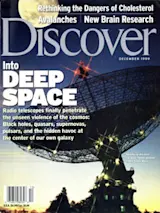Within three years, if not sooner, the Human Genome Project will be completed, and all 3 billion or so bases of the human genetic code will have been recorded. That's when biologists will face up to an uncomfortable truth: Less than 5 percent of the human genome is likely to contain functioning genes. The rest of it is stuffed—like a stranger's attic—with mysterious relics of an unknown past. Nearly half is parasitic dna—commonly known as "transposable elements,” or simply "transposons,” and everything left over is just anonymous noncoding dna. Over the years, scientists have downplayed the significance of this excess genetic baggage, referring to it disdainfully as "junk” dna. But now the tide is turning—for transposons at least—as biologists begin to recognize that these tiniest of parasites may have been real players in evolution after all. Without their insidious presence, complex creatures like us may never have evolved. These rogue ...
Transposons
So-called junk DNA proves its worth: First in corn, now in creatures like us
More on Discover
Stay Curious
SubscribeTo The Magazine
Save up to 40% off the cover price when you subscribe to Discover magazine.
Subscribe













